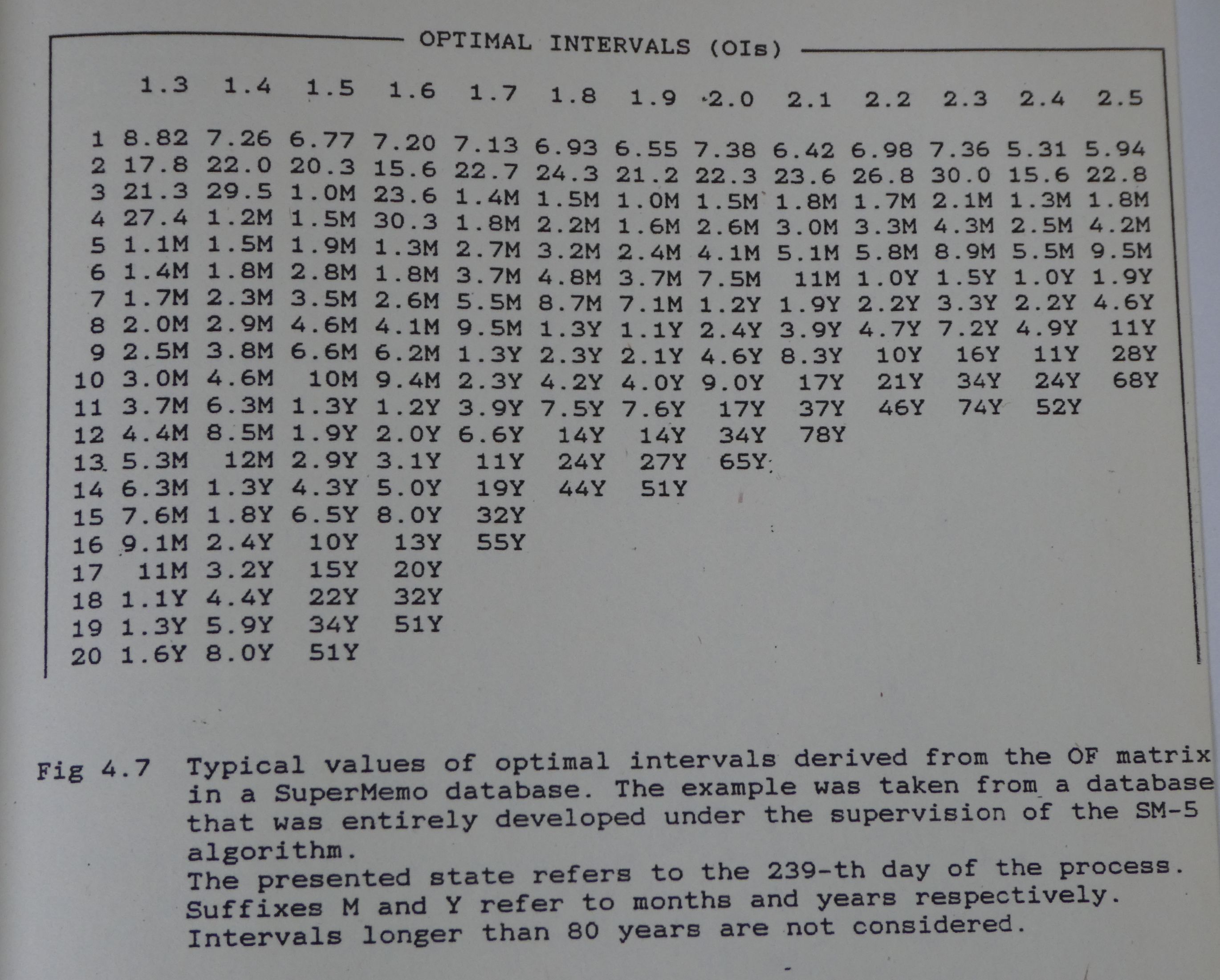Piotr Wozniak, 1990
This text was taken from P.A.Wozniak, Optimization of learning, Master’s Thesis, University of Technology in Poznan, 1990 and adapted for publishing as an independent article on the web. (P.A.Wozniak, Feb 22, 1999)The main fault of the Algorithm SM-2 seemed to have been the arbitrary shape of the function of quasi-optimal intervals. Although very effective in practice and confirmed by years of experimental repetitions, this function could not claim scientifically proved validity, nor could it detect the overall impact of few day variations of optimal intervals on the learning process. Bearing these flaws in mind I decided to implicate routine SuperMemo repetition in validation of the function of optimal intervals!
Using optimization procedures like those applied in finding E-Factors I wanted the program to correct the initially proposed function whenever corrections appeared justified.
To achieve this goal, I tabulated the function of optimal intervals (see Fig. 3.2).
(Fig. 3.2)[in SuperMemo 98 see Tools : Statistics : Analysis : Matrices : Intervals]
Particular entries of the matrix of optimal intervals (later called the OI matrix) where taken from the formulas used in the Algorithm SM-2.
SuperMemo 4 (February 1989), in which the new solution was implemented, used the OI matrix to determine values of inter-repetition intervals:
I(n):=OI(n,EF)
where:
I(n) – the n-th inter-repetition interval of a given item (in days),
EF – E-Factor of the item,
OI(n,EF) – the entry of the OI matrix corresponding to the n-th repetition and the E-Factor EF.
However, the OI matrix was not fixed once for all. In the course of repetitions, particular entries of the matrix were increased or decreased depending on quality of responses. For example, if the entry indicated the optimal interval to be X and the used interval was X+Y while the response quality after this interval was not lower than four, then the new value of the entry would fall between X and X+Y.
Thus the values of the OI entries in the equilibrium state should settle at the point where the stream of poor-retention items balances the stream of good-retention items in its influence on the matrix.
As a consequence, SuperMemo 4 was intended to yield an ultimate definition of the function of optimal intervals.
Algorithm SM-4 used in SuperMemo 4.0:
- Split the knowledge into smallest possible items
- With all items associate an E-Factor equal to 2.5
- Tabulate the OI matrix for various repetition numbers and E-Factor categories (see Fig. 3.2)[similar matrix can be viewed as the Optimum Interval matrix in SuperMemo 98 with Tools : Statistics : Analysis : Matrices : Intervals]
- Use the following repetition spacing to obtain the initial OI matrix:OI(1,EF):=1
OI(2,EF):=6
for n>2 OI(n,EF):=OI(n-1,EF)*EFwhere:OI(n,EF) – optimal inter-repetition interval after the n-th repetition (in days) for items with E-Factor equal EF, - Use the OI matrix to determine inter-repetition intervals:I(n,EF):=OI(n,EF)where:I(n,EF) – the n-th inter-repetition interval for an item whose E-Factor equals EF (in days),
OI(n,EF) – the entry of the OI matrix corresponding to the n-th repetition and the E-Factor EF - After each repetition estimate the quality of the repetition response in the 0-5 grade scale (cf. Algorithm SM-2).
- After each repetition modify the E-Factor of the recently repeated item according to the formula:EF’:=EF+(0.1-(5-q)*(0.08+(5-q)*0.02))where:EF’ – new value of the E-Factor,
EF – old value of the E-Factor,
q – quality of the response in the 0-5 grade scale.
If EF is less than 1.3 then let EF be 1.3. - After each repetition modify the relevant entry of the OI matrix.
- An exemplary formula could look as follows (the actual formula used in SuperMemo 4 was more intricate):OI’:=interval+interval*(1-1/EF)/2*(0.25*q-1)
OI”:=(1-fraction)*OI+fraction*OI’where:OI” – new value of the OI entry,
OI’ – auxiliary value of the OI entry used in calculations,
OI – old value of the OI entry,
interval – interval used before the considered repetition (i.e. the last used interval for the given item),
fraction – any number between 0 and 1 (the greater it is the faster the changes of the OI matrix),
EF – E-Factor of the repeated item,
q – quality of the response in the 0-5 grade scale.Note that for q=4 the OI does not change and that for q=5 the OI increases 4 times less than it decreases for q=0.
Note also that the maximum change of the OI equals (I(n)-I(n-1))/2 in terms of the repetition spacing used in Algorithm SM-2 (i.e. (OI-OI/EF)/2). - 8. If the quality response was lower than 3 then start repetitions for the item from the beginning without changing the E-Factor.
- 9. After each repetition session of a given day repeat again all the items that scored below four in the quality assessment. Continue the repetitions until all of these items score at least four
As it was mentioned earlier, the Algorithm SM-4 was implemented in SuperMemo 4 and was used between March 9, 1989 and October 17, 1989. Although the main concept of modifying the function of optimal intervals seemed to be a major step forward, the implementation of the algorithm was a failure. The basic insufficiency of the algorithm appeared to result from formulas applied in modification of the OI matrix.
There were two the most striking flaws:
- modifications were too subtle to rearrange the OI matrix visibly in a reasonably short time,
- for longer inter-repetition intervals, the effect of modification had to wait very long before being steadily fixed, i.e. it took quite a lot of time before the result of a modification of a few-month-long interval could be seen and corrected if necessary
After seven months of using the SM-4 algorithm the OI matrices of particular databases did not look much different from their initial states. One could explain this fact by the correctness of my earlier predictions concerning the real values of the optimal inter-repetition intervals, however, as it was later proved by means of the Algorithm SM-5, the actual reason of the stability of the matrices was the deficient optimization formulae.
As far as acquisition rate and retention are concerned, there is no reliable evidence that the Algorithm SM-4 brought any progress. Slight improvement could as well be related to general betterment of the software and improvement in item formulation principles



